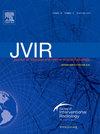单色同步辐射 X 射线显微血管造影描绘亚胺培南/西司他丁在体内的微栓塞效应
IF 2.6
3区 医学
Q2 PERIPHERAL VASCULAR DISEASE
Journal of Vascular and Interventional Radiology
Pub Date : 2025-02-01
DOI:10.1016/j.jvir.2024.10.025
引用次数: 0
摘要
目的:阐明亚胺培南/西司他丁(IPM/CS)作为体内微血管栓塞材料的特性:提前在三只健康兔子的一个耳廓皮下注射吡卡尼,以建立炎症诱导的新生血管模型。使用从大型同步辐射设施(超光子环-8;SPring-8)获得的单色 X 射线进行微血管造影。所有兔子都在麻醉状态下接受了栓塞前微血管造影。然后使用 IPM/CS(0.2 克)+ 非离子造影剂(2 毫升)的混合物从耳廓动脉中央分支进行栓塞。栓塞后立即进行微血管造影,并在栓塞后 10、20、30、40、50、60、70、80 和 90 分钟进行造影。根据栓塞后立即拍摄的图像测量栓塞血管的直径。评估了栓塞后至栓塞后 90 分钟的再通畅时间,并对正常部位和诱发炎症的部位进行了比较:结果:正常部位栓塞后立即评估的栓塞血管平均直径为 267 ± 58.35(范围:174-363)微米。对栓塞后血管再通的评估显示,正常部位的血管平均在 70 分钟(范围:50-70)后再通,而炎症部位的血管在栓塞后 90 分钟内都没有再通:本研究将 IPM/CS 鉴定为体内栓塞物质,正常部位和炎症部位的栓塞效应持续时间不同:IPM/CS表现出的超短栓塞效应是现有栓塞材料所不具备的,它可能对发炎血管而非正常血管具有特定的长栓塞效应。这一特性可能有助于将栓塞适应症扩展到新的疾病,如栓塞缓解慢性关节疼痛。本文章由计算机程序翻译,如有差异,请以英文原文为准。

Microembolization Effects of Imipenem/Cilastatin In Vivo Depicted by Monochromatic Synchrotron X-Ray Microangiography
Purpose
To elucidate the characteristics of imipenem (IPM)/cilastatin (CS) as an embolic material in microvessels in vivo.
Materials and Methods
Three healthy rabbits were injected subcutaneously in 1 auricle with picibanil (OK-432) in advance to create an inflammation-induced neovascular model. Microangiography was performed using monochromatic X-rays obtained from a large synchrotron radiation facility (SuperPhoton ring-8 GeV, SPring-8). All rabbits underwent pre-embolic microangiography under anesthesia. Embolization from the central branch of the auricular artery was then performed using a mixture of IPM/CS (0.2 g) + nonionic contrast medium (2 mL). Microangiography was performed immediately after and at 10, 20, 30, 40, 50, 60, 70, 80, and 90 minutes after embolization. The diameter of embolized vessels was measured from the images immediately after embolization. Recanalization times were evaluated from immediately after embolization to 90 minutes after embolization, and they were compared between normal sites and sites where inflammation was induced.
Results
The mean diameter of the embolized vessels immediately after embolization evaluated at the normal site was 267 μm (SD ± 58.35; range, 174–363 μm). Evaluation of postembolic recanalization showed that vessels in the normal sites recanalized after a mean of 70 minutes (range, 50–70 minutes), whereas vessels at the sites of inflammation did not recanalize in observations up to 90 minutes after embolization.
Conclusions
Microangiography using monochromatic X-rays produced from large synchrotron radiation showed that vessels larger than the IPM/CS particles were initially occluded, but the embolic effect resolved in normal vessels within 70 minutes and persisted in inflamed vessels. IPM/CS may thus exert a selective embolic effect on inflammation-related neovasculature.
求助全文
通过发布文献求助,成功后即可免费获取论文全文。
去求助
来源期刊
CiteScore
4.30
自引率
10.30%
发文量
942
审稿时长
90 days
期刊介绍:
JVIR, published continuously since 1990, is an international, monthly peer-reviewed interventional radiology journal. As the official journal of the Society of Interventional Radiology, JVIR is the peer-reviewed journal of choice for interventional radiologists, radiologists, cardiologists, vascular surgeons, neurosurgeons, and other clinicians who seek current and reliable information on every aspect of vascular and interventional radiology. Each issue of JVIR covers critical and cutting-edge medical minimally invasive, clinical, basic research, radiological, pathological, and socioeconomic issues of importance to the field.

 求助内容:
求助内容: 应助结果提醒方式:
应助结果提醒方式:


